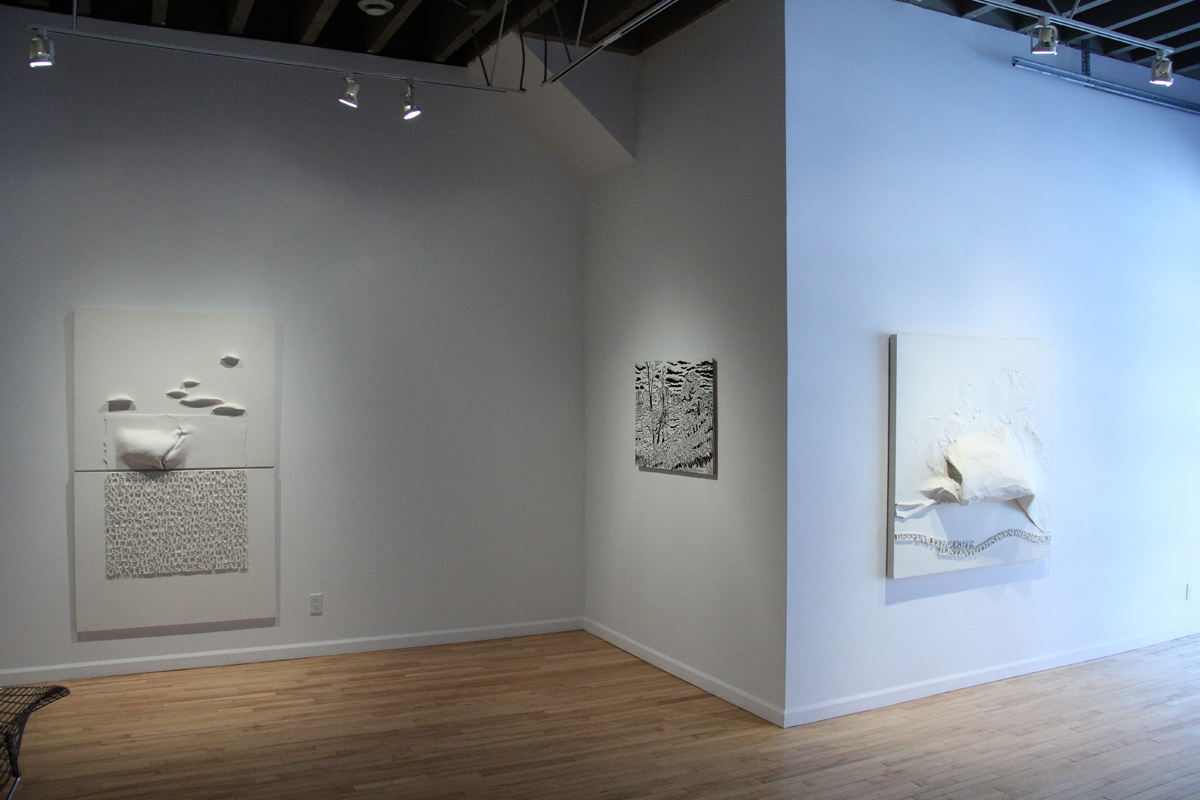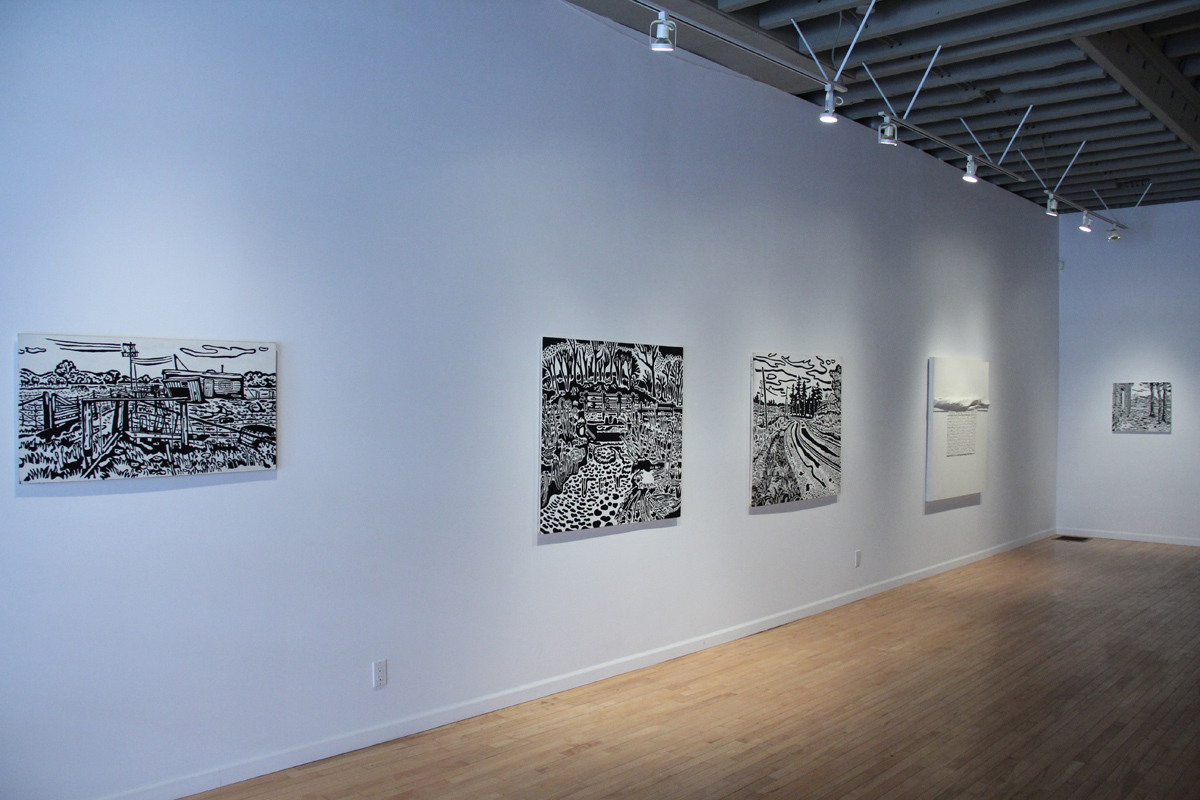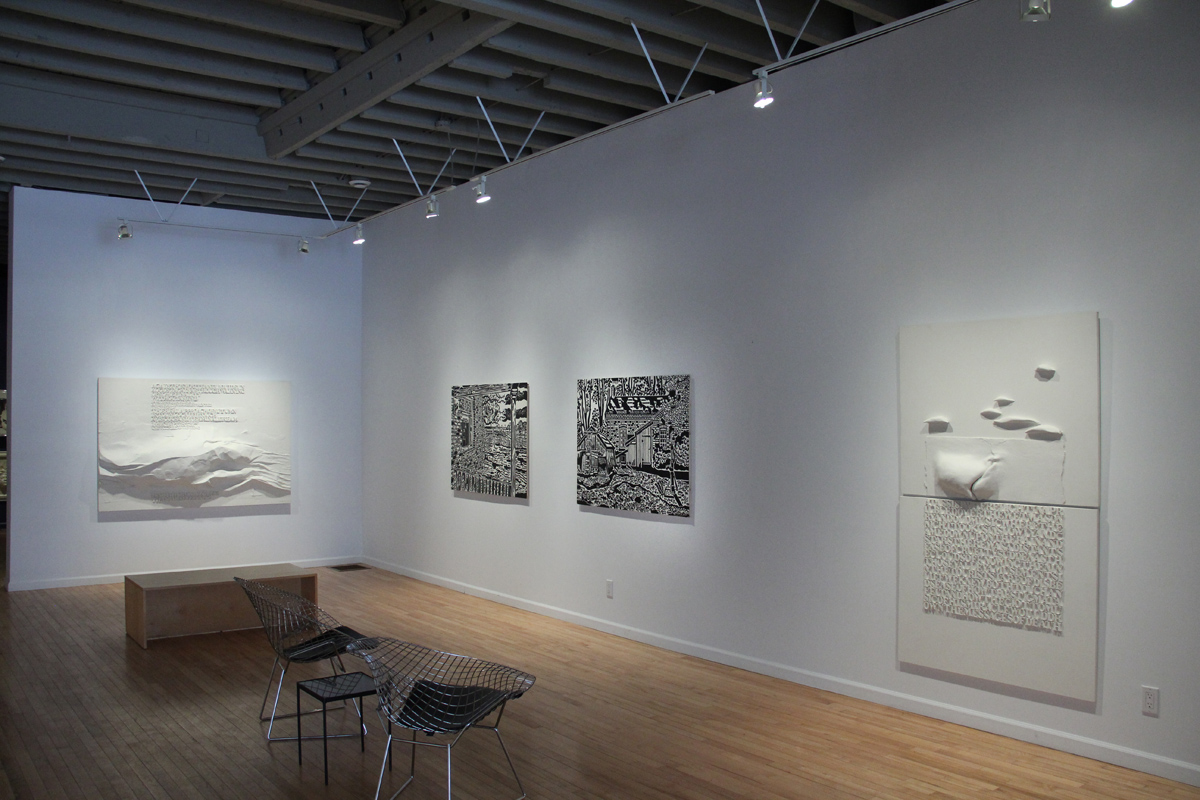Clark McDougall & Margot Ariss “Black & White” — April 5 – 26, 2014
“Black and White” is a beautiful exhibition pairing for the first time Margot Ariss and Clark McDougall. We recently discovered these immensely powerful black enamel on white gesso paintings by Clark McDougall. Why were they just black and white when he was also making very colourful paintings at this time? We believe he was experimenting with the abstract thought of allowing the viewer to participate with the painting.
Putting these crisp contrasting paintings with the romantic works of Margot Ariss has made for an very serene and sexy exhibition. Margot’s confidence with her poems and delicate shapes hang beautifully with Clark’s jet black designs.
Margot Ariss
Margot Ariss’s sculpted clay panels from the early 1980s combine clay letters with complex molded and shaped forms. Plaster, canvas, cloth, acrylic and cellulose are combined to build up the smooth rolling designs that hint at clouds, snow falls, storms and landscapes. She appeals to our emotions through the combined use of light and shadow and the poignant clay lettered poems.
Margot Ariss was born in 1929 in Belleville, ON. She moved to London in 1940 and attended H. B. Beal Secondary School where she met her husband, artist & teacher Herb Ariss.
Margot began working as a sculptor in the late 1950’s, stamping words into soft clay with a child’s set of wooden letters. Throughout the 1960s and 70s, she created intricate text-based clay wall panels, pots and cubes by scratching, stenciling or stamping personal poems or quotations into the clay. Margot was an avid reader and poet and often used quotations from Michael Ondaatje and John Bruce in her sculpture, illuminating the meaning of their poetry into elegant, visual, sculptural equivalents.
Her later works from the 1980s combine clay, cloth and paper mache. They still contain some text, but rely more heavily on smooth rolling designs and sculptural forms that reference snow falls, storms and empty landscapes.
Margot Ariss’s work is in the collections of the Vancouver Art Gallery, Canada Council Art Bank and the Beaverbrook Art Gallery. She was included in “Ceramics 69” at the Vancouver Art Gallery in 1969 and selected ceramic group exhibitions at the AGO in the early 1970s. In 1989, the London Regional Art Gallery mounted a survey exhibition – “Zen Song” – curated by Paddy O’Brien.
Clark McDougall
Clark McDougall is best known for his “black enamel” paintings where the outline is very important to the structure and design of the painting. These newly discovered 1970s black enamel paintings on white gesso background reveal McDougall’s incredible mastery of composition and rhythm.
Clark McDougall was born in St. Thomas in 1921. At the age of 16 Clark left high school determined to become an artist. He would ride his bike north of St. Thomas into North Yarmouth and paint watercolours directly from nature. He taught himself proper technique from library books and sought advice from local artist William St. Thomas Smith. In 1950, at the age of 29, Clark traveled to Montreal and Quebec City where he first experienced the paintings of Henri Matisse. He now realized that colour and line could be used in a completely different way. By 1952-3 Clark was working as a “Fauve” painter, where his colours were intensely vivid and non-naturalistic.
A coronary in 1957 forced Clark to paint from photographs in his studio. His painting style changed where the outline became very important to the structure and design of the painting. Clark’s unique “black enamel” style set him apart from other regional artists. His first exhibition of these “black enamel” paintings was in 1968 at the 20/20 Gallery, London. In 1976 the Volunteer Committee at the London Regional Art Gallery commissioned a painting, “Site”, to commemorate the building of the new gallery. In 1977 the Vancouver Art Gallery organized an exhibition “Clark McDougall: Paintings since 1953”.
Regardless of the style, however, Clark had a highly individual way of interpreting his beloved landscape of North Yarmouth. Clark McDougall passed away of a brain tumor in 1980 at the age of 59. In 1987 the London Regional Art Gallery mounted a large retrospective exhibition of Clark’s work. Most recently in 2011, the McIntosh Gallery, UWO produced a hard-cover book to accompany their exhibition “Fugitive Light: Clark McDougall’s Destination Places”. Michael Gibson Gallery represents the Estate of Clark McDougall. His paintings are in countless corporate collections as well as the Art Gallery of Ontario, Vancouver Art Gallery, Museum London and the Canada Council Art Bank.
Link to Margot Ariss Artist Page HERE
Link to Clark McDougall




